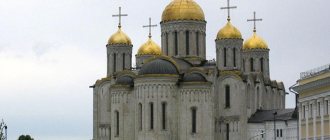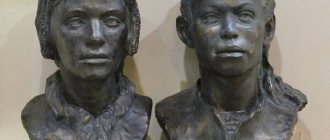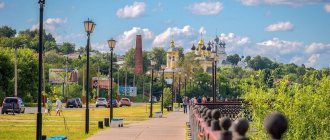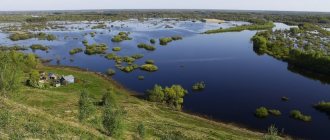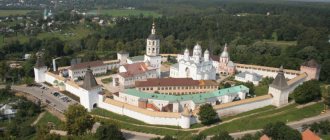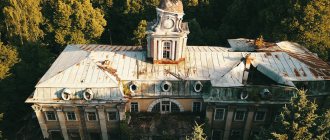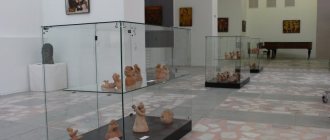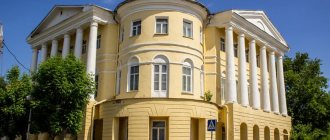| Sights Museums Stories, reviews and tourist routes Where to stay in Aleksandrov |
Alexandrov is a city in the north-west of the Vladimir region, 120 km from the regional center and 100 km from Moscow. Thanks to two passing railway lines and its location along the route of the Golden Ring of Russia, it is an unofficial participant.
The small town is surrounded by green fields, vast forests and lies along the banks of the thin winding Seraya River. On its chaotically scattered streets there is a motley carpet of high-rise buildings and small private estates. The quiet, calm city is not yet as popular among tourists as other points on the tourist route, but in the 16th century it became the scene of quite famous historical events.
The Great Sloboda, the village of Alexandrovo or Alexandrovskaya Sloboda, received active development at the beginning of the 16th century. Representatives of the aristocracy often visited it on their way to the monasteries northeast of the capital, and personal chambers and monasteries were even built by the Sovereign of All Rus', Vasily III. During the reign of Ivan the Terrible, the village became the center of the oprichnina and for some time actually the main residence of the country. It was then that the well-known review of brides by Ivan the Terrible was held within the walls of the royal buildings, after which Marfa Vasilievna Sobakina briefly became queen, and ten years later the settlement acquired a dark imprint in its history and is listed as the place of death of Tsarevich Ivan, the reasons for which are still not exactly clear .
Panorama from the bell tower of the Church of the Crucifixion Photo: © Marina Gololobova
An undoubted magnet for tourists is the historical part of the city in the area of Sovetskaya Street and within the walls of the local Kremlin, called Aleksandrovskaya Sloboda. On its territory many “scenery” of past years have been preserved, some of them date back to the very beginning of the 1500s. It’s worth coming to Alexandrov to feel the spirit of that Rus', see the unique architecture and be inspired by the history of your country. One day is enough for a good trip; perhaps more time is needed for a profound one.
TOP 5 - what to visit in Alexandrov in 1 day
First, we’ll tell you about the main attractions of Alexandrov, which you can see in one day. In particular, we are talking about the Alexander Kremlin - a museum-reserve and beautiful Kremlin cathedrals.
Museum-reserve "Alexandrovskaya Sloboda" (Kremlin)
- Address: Museum pr., 20.
Many travelers begin their acquaintance with the ancient settlement by visiting the Alexander Kremlin. It is slightly smaller than the Moscow one, but, like its older brother, it is repeatedly mentioned in the chronicles of those times. The residence of Ivan the Terrible is well preserved.
The 17th century in the history of the Kremlin was marked by the construction of new fortress walls and the construction of cornerstone towers. At the same time, a women's monastery was founded here. During the Soviet years it was closed. Nowadays it is a museum-reserve. The revived Holy Dormition Monastery is also located on its territory.
In addition to the monastery, there are several churches on the lands of the Alexander Kremlin.
Trinity Cathedral
- Address: Museum pr., 20.
The date of construction of the Trinity Church (until the end of the 17th century it was called the Intercession Cathedral) is judged by documents indicating the time of its consecration. This event took place in 1513.
The opinion of historians about the similarity of the Trinity Church with the cathedrals of the Moscow Kremlin is divided. Scientists claim that it has common features with the Arkhangelsk and Annunciation churches, built in the same historical era.
The bell tower, standing alone, was built together with the temple or a little later. It is known that, having made Alexandrov the capital, Ivan the Terrible ordered it to be remodeled by building the Church of the Crucifixion.
In the Trinity Cathedral there are doors from the St. Sophia Church in Veliky Novgorod. They were reinstalled after the sack of the city, by order of the king. This ancient oak gate in the Novgorod Church of St. Sophia was erected in 1336. Their splendor is emphasized by copper trim and gold painting. Each half of the door is decorated with 2 paintings on a biblical theme. Another gate of the Trinity Church (western), removed from one of the cathedrals in Tver.
In 1922, many items of historical and cultural value were removed from the church. After 4 years, the small temple domes were removed. The ministries were revived in 1946. For many years, Trinity Cathedral became the only place in the area where believers could gather.
Restoration of the temple began in the 80s of the last century. In 2010, the iconostasis was restored. Now it consists of 5 tiers.
Assumption Church
- Address: Alexander Kremlin.
The history of the Assumption Church begins at the time when Ivan the Terrible settled in Alexandrov. By his order, a new church was erected. In 1564, the tsar recruited a monastic brethren from the guardsmen. At the same time, he himself put on the robes of a monk and introduced monastic order.
In the 17th century, thanks to the efforts of Elder Lucian, a women’s monastery began to form here. In 1651, by decree of Tsar Alexei Mikhailovich, the monastery received some lands of the Alexander Sloboda and the Assumption Church.
The monastery has seen many famous personalities of that time in its lifetime. The sisters of Peter I were tonsured here as nuns, and disgraced court ladies were exiled here. Royalty also did not refuse to help the monastery. Alexei Mikhailovich, Peter I, Empress Elizaveta Petrovna, Catherine II - they all made contributions to the monastery.
In 1764, new monastic states were approved. The Assumption Alexander Monastery was classified as 1st class. At that time there were only 4 similar monasteries throughout Russia.
The nuns who lived in the monastery learned church hymns and preparing prosphora. Their embroidery of church vestments and ability to sew chasubles for icons became famous far beyond the monastery. In the last years of the 19th century, a school for girls operated here. At the monastery there was a hospice house, a hospital and a handicraft workshop.
The destruction of the monastery began during the revolution, although in 1919 the idea of creating a museum-reserve on the territory of the monastery was put forward. In 1923, the Assumption Alexander Monastery was abolished. Six months later, the temple from which monastic life began was also taken away from the believers.
In the same year, the Aleksandrovskaya Sloboda museum was opened. All church property became exhibits of a historical reserve. During the Soviet years, the monastery buildings gradually fell into disrepair. The first restoration began only in 1960. The monastery was reopened in 1991.
Church of the Intercession
- Address: Museum pr., 20.
Historians call the Church of the Intercession the first tented cathedral in Russia. Its construction dates back to 1510. The author who built the church is considered to be the famous Italian architect Aleviz Novy. His works include many churches built in the 16th century on the territory of the Moscow and Alexander Kremlin.
The peculiarities of the style of the Italian architect include the interrelation of elements of traditional Russian architecture and the Renaissance.
Unique ancient frescoes have been preserved inside the tent of the Intercession Church. Biblical characters and Russian princes are the main themes of church painting. It was preserved thanks to restoration carried out in the last century.
At present, there are no services in the temple. The church became one of the objects of the Alexander Sloboda museum. The “Dining Chamber” exposition located in the Intercession Cathedral will be interesting for visitors. The exhibits will tell you about the royal menu and dining etiquette of the 16th century. The interior of the rooms where Ivan the Terrible received foreign ambassadors and his guests has been completely restored.
History of Alexandrovskaya Sloboda
History of the area in antiquity and the Middle Ages
According to archaeological research, the first settlements in this area appeared in the Mesolithic era. 3-1.5 thousand years ago there were settlements of the Dyakovo culture here - the settlements of Rupusovo (near the village of Rupusovo) and the Golden Bowl (near Antonka).
The Dyakovites were replaced by the Finno-Ugric tribes of Murom and Merya, who subsequently mixed with those who came here at the end of the 1st millennium AD. Slavic tribes of the Ilmen Slavs, Krivichi and Vyatichi. At the beginning of the 2nd millennium AD. this territory became part of the Rostov-Suzdal Principality, from 1175 to 1302 - into the Pereslavl-Zalessky Principality, and then into the Moscow Principality.
Under Prince Ivan Danilovich Kalita (c. 1283 - 1340 or 1341), the lands devastated by the Tatars around Moscow began to be populated by “slobodas” - newcomers. One of the settlements was boyar Andrei Kobyla (died after 1347), the first reliably known ancestor of the Romanov dynasty. The courtyard of Andrei Kobyla was located 10 km from the current Aleksandrovskaya Sloboda, in Kobylina Sloboda, now the village of Kalinino.
After 1340, part of the lands came into the possession of the Moscow metropolitans. the Great Settlement appears on the road leading from the Trinity Monastery to Pereslavl-Zalessky . The central village was owned by the boyar Alexander Ivanovich Starkov, which after his death passed to his brother Alexei and was named Alexandrovskaya Sloboda, later - Staraya Sloboda.
The new village of Alexandrovskoye under Vasily III
In the 15th century, Aleksandrovskaya Sloboda became a resting place for Moscow princes during pilgrimage trips to Pereslavl-Zalessky. According to the spiritual charter of Ivan III, the New village of Alexandrovskoye was bequeathed to his son Vasily. In the 1510s, by order of Vasily III (1479-1533), Russian and Italian craftsmen began to build a grand ducal courtyard here with chambers, temples and outbuildings.
Trinity Cathedral in the Holy Dormition Monastery (Alexandrovsky Kremlin)
Vasily III came here several times with his wife Elena Glinskaya (c. 1508-1538). After the death of the Grand Duke, the village passed to his widow and became the “oprichna” possession of Elena Glinskaya. In 1534, fortifications began to be built in the New Village of Alexandrovskoye.
Alexandrovskaya Sloboda under Ivan the Terrible
The next owner of the Aleksandrovskaya Sloboda was Ivan IV the Terrible (1530-1584), who lost his parents early and treated everything connected with them with special warmth. The most important state issues were resolved here, and the governors who distinguished themselves in the Livonian War were honored.
In December 1564, Ivan the Terrible moved to Aleksandrovskaya Sloboda “from many stone affairs” so that “God would instruct him, the sovereign.” The well-fortified residence turned into the unofficial capital of Russia and the center of the oprichnina.
Assumption Church in the Holy Dormition Monastery (Alexandrovsky Kremlin)
At the same time, the king, who adopted Byzantine ideas and customs, invited the best architects and icon painters here. The ensemble of the Alexander Kremlin was second only to the Moscow Kremlin in its beauty and grandeur. The best singers and musicians were brought to the settlement from all over the country. The terrible king himself took part in the “composition” of music.
The first provincial printing house in Russia was opened in Sloboda, where in 1577 Andronik Nevezha, a student of pioneer printer Ivan Fedorov, published the “Sloboda Psalter.” A book-writing workshop also operated here, where the Litsey Chronicle was compiled. It is possible that the famous library of Ivan the Terrible was also kept in the Alexandrovskaya Sloboda, the basis of which was made up of books from the collection of the Tsar’s grandmother, Sophia Palaeologus (c. 1455-1503).
Church of the Intercession in the Holy Dormition Monastery (Alexandrovsky Kremlin)
The history of the first Russian Icarus is connected with the Aleksandrovskaya Sloboda, reflected in the ancient “Tale of the Smerde Nikitka, the slave of the boyar’s son Lupatov,” who made wings from wood and leather and, having climbed the Crucifixion Church-bell tower , flew around the settlement. Alas, Ivan the Terrible executed the hero for the fact that “man is not a bird and has no wings.”
Crucifixion Church-bell tower in the Holy Dormition Monastery (Alexandrovsky Kremlin)
In the Alexandrovskaya Sloboda, the Russian Tsar was married twice: in 1571 to Marfa Sobakina (third wife), who died less than two weeks later under strange circumstances, and in 1575 to Anna Vasilchikova. In 1573, Maria Dolgorukaya, whom Ivan the Terrible suspected of infidelity, was drowned in the Seraya River.
On November 16, 1581, Tsarevich Ivan (1554-1581) died in Aleksandrovskaya Sloboda: “as some say that his life was extinguished by the blow of his father’s hand because he wanted to keep his father from some unseemly act” (Vremennik of clerk Ivan Timofeev).
Ilya Repin. Ivan the Terrible and his son Ivan November 16, 1581, 1883-85, State Tretyakov Gallery, Moscow
Accompanying the funeral procession, Ivan the Terrible left Aleksandrovskaya Sloboda forever.
♦ Read more: Alexandrova Sloboda - the magnificent Sovereign Court of Vasily III and Ivan IV the Terrible
Alexandrovskaya Sloboda in the 17th century
In 1609 and 1611, the Aleksandrovskaya Sloboda was twice captured and devastated by the Poles. It was liberated by the militia of Minin and Pozharsky, and from here they moved to Moscow. After the Romanov dynasty came to power, Aleksandrovskaya Sloboda became a palace village and was called Slobodsky Stan. In 1630, a new wooden palace was built on the site of the destroyed old one. It burned down in 1730 and was never rebuilt afterwards. , the Holy Dormition Convent was founded on the site of the royal residence .
Assumption Convent, Cell Building
On September 15, 1689, 17-year-old Peter I arrived in Alexandrovskaya Sloboda, accompanied by his mother and wife, having fled from his sister, Princess Sophia. Following them, Patriarch Joachim and the “amusing troops” of the young king moved here. Nearby, on the German Hills, they began to conduct exercises.
Alexandrovskaya Sloboda in the 18th century
Martha , whom the tsar suspected of supporting the Streltsy rebellion of 1689, was forcibly tonsured into the Assumption Convent under the name Margarita Here she lived until her death in 1707. Chambers were added especially for her to the Crucifixion Church-bell tower, in which her personal belongings were preserved. In 1718, Peter's first wife, Evdokia Lopukhina .
Exposition dedicated to Marfa Alekseevna (1652-1707)
After the death of Peter I, the Aleksandrovskaya Sloboda, which in 1709 became the center of the Aleksandrovsky district of the Vladimir-Kostroma governorate, went to Catherine I. After the death of the Empress, the settlement passed to Tsesarevna Elizabeth Petrovna. In 1730, Elizabeth was exiled here by Empress Anna Ioannovna. At first she lived in an old palace, and then a spacious wooden palace on a stone foundation was built on the “Tsar’s Mountain”. Elizabeth, despite her imprisonment, spent time in noisy companies, on hound hunts, ice skating and sledding in winter and on a boat in summer. In 1740, Peter's daughter left the Alexandrovskaya Sloboda and was soon elevated to the imperial throne. In 1744, the Empress visited her and was joyfully received by the local residents.
By decree of Empress Catherine the Great, on September 1, 1778, Alexandrovskaya Sloboda received the status of a district town of Alexandrov. The Seraya River divided the city into two parts - the commercial and industrial Posad and Zarechye, where the Assumption Monastery rises. According to the census, the city's population at that time was 1,859. In Posad there were 93 trading shops, 4 drinking establishments, 3 tanneries and a malt factory; there were 165 merchant and 200 petty-bourgeois houses. In Zarechye there were 95 shops, 5 drinking houses, 5 tanneries and malt factories, 68 merchant and petty bourgeois houses, 43 forges.
The population of Alexandrov was mainly engaged in trade and various crafts. Blacksmithing was especially famous, which was reflected in the city’s coat of arms approved in 1781. Residents of the settlement were also engaged in paper and weaving production, which developed through the efforts of the merchants Baranovs and Zubovs. In 1846, the Troitsko-Alexandrovskaya paper and weaving factory was founded.
Alexandrov in the 19th - early 20th centuries
The fire that occurred on May 1, 1818 destroyed all wooden buildings in Posad. In August 1823, Emperor Alexander I stayed in Alexandrov.
On January 1, 1870, a railway was opened from Sergiev Posad through Aleksandrov to Rostov. It gave a powerful impetus to the development of industry, new leather, dyeing, and paper factories appeared. In 1903 the station building was built.
Alexandrov was also at the center of the events of the first Russian revolution of 1905-1907. For five days, from December 7 to 12, the uprising of local workers continued in the city, which went down in history under the name “Alexander’s Republic.”
City of Alexandrov, st. Soviet
Alexandrov in the XX - XXI centuries
The development of the city continued after the 1917 revolution. In 1930, a power station was built. In 1932, radio plant No. 3 was transferred from Moscow to Aleksandrov, the city became one of the leading centers of the radio engineering industry. SVD and ARZ radios were produced here, and in the late 40s and early 50s the production of KVN and Record televisions was established.
In Alexandrov, which received the unspoken name of “the capital of the 101st kilometer,” many public figures who were repressed under Stalin lived. After the formation of the Vladimir region on August 14, 1944, Alexandrov became part of it.
The heyday occurred in the 1960-1980s. In the 1960s, a semiconductor plant named after the 50th anniversary of the October Revolution was opened in the city. On July 23, 1961, mass riots occurred, in which about 1,200 people took part.
In the 1990s, the most important city-forming enterprises were closed, city residents found themselves without work, and many were forced to leave. In the early 2000s, the Turkish company Vestel opened a plant for assembling televisions and household appliances.
Soviet square
Other famous churches and temples of Alexandrov
In addition to the religious sites located on the territory of the Kremlin, in Alexandrov you can find several more shrines belonging to the Orthodox Church.
Church of Seraphim of Sarov
- Address: Vokzalnaya st., 12.
The history of the emergence of the temple in the name of Seraphim of Sarov is interesting, although it is not very long. The church appeared on the site of a small chapel built on Vokzalnaya Square in Alexandrov.
In 1870, a railroad passed through the city. It connected Moscow with Yaroslavl and Arkhangelsk. In 1888, a small chapel with an iconostasis was erected near the station. It was dedicated to the miraculous rescue of the imperial (Alexander III) family during a train crash.
Initially, only railway employees came here. But soon the chapel could not accommodate all the believers. It was decided to build a temple.
The church was built very quickly. It began to be built in 1904. Within a year, she was ready to receive believers. The temple was built in the traditions of Russian architectural style. The building of a small and cozy church named after Seraphim of Sarov has its own unique image. The temple has an elegant decor and is a decoration of the square near the railway station.
In the 30s of the last century, the church suffered from religious persecution. In its building there was a barracks with shops and a canteen. The shrine was returned to believers in 2003. After restoration, the church became a decoration of the small Aleksandrov, which has a long history.
Cathedral of the Nativity of Christ
- Address: Cathedral Square, 1.
The Nativity Cathedral is not a monumental building. Nor did it become an architectural masterpiece. But in Russia there are few churches with such a rich history.
Back in 990, more than 1000 years ago, a wooden church was built in the name of St. Nicholas the Wonderworker. In this place there was a settlement of the ancient Slavs. Its territory grew rapidly, and in the 11th century the first Church of the Nativity of Christ was built.
As the years passed, the temple acquired new chapels. Emperor Peter I was also involved in its transformation. By his order, on the site of 2 wooden churches, the first stone Nativity Cathedral was built. This happened in 1696. The temple also had its own bell tower.
Alexander merchants in the 19th century, using personal funds, expanded and rebuilt the church complex. The revolution brought many changes to the life of the religious shrine. Instead of church hymns, operas were performed here, and amateur art groups were active. Later, there was a bakery in the premises of the temple.
A return to the values of Orthodoxy occurred at the end of the 20th century. Religious sites were restored throughout the country, temples and churches were returned to believers. The Nativity Cathedral was also lucky. Since the beginning of the 90s of the last century, worship services have resumed here, and restoration has begun. Today there is a Sunday school at the temple, there is a baptism and a prosphora bakery. The church complex also includes a library.
Townspeople consider the place where the Nativity Cathedral is located to be one of the most pleasant and cozy places in Alexandrov.
Church of the Kazan Icon of Our Lady
- Address: Alexandrovsky district, Staraya Sloboda village, Tsentralnaya st., 33.
The temple building was built in the last years of the 17th century. The church was erected in Staraya Sloboda, a place that belonged to a famous boyar family since the 15th century. Nearby there is a road leading to Moscow and Vladimir. Over the years, the first wooden church of St. Nicholas the Wonderworker was visited by many Russian princes. Historians believe that Alexander Nevsky also visited here.
The stone church of the icon of the Kazan Mother of God was erected by order of Peter I. The emperor fulfilled the last will of his deceased brother, Ivan Alekseevich. The temple has 5 domes with a bell tower. Its architectural style is Moscow Baroque, with elements of classicism.
The main shrine of the church is the Kazan Icon of the Mother of God, brought from the Simeon Monastery. She became famous for her miraculous healings. The temple was very popular among believers. Empress Catherine II visited him in 1760.
The church accepted believers until 1928. Later, the local priest was first arrested and then shot. The temple was plundered, almost all of its property was lost. Since the 90s of the 20th century, restoration work began here. Nowadays the Church of the Kazan Icon of the Mother of God is an active temple and an object of cultural heritage of Russia.
Church of the Bogolyubskaya Icon of the Mother of God
- Address: Bazarnaya street, 8.
The temple was built at the city cemetery in 1800. Somewhat later, a bell tower was erected next to it. It had 3 tiers. The entire church area was surrounded by a stone fence. A quarter of a century later, 2 chapels were added to the refectory of the Bogolyubsky Cathedral - the first, in the name of the Great Martyr Barbara, the second, in honor of Fyodor Stratilates.
The icon that gave the temple its name is revered as miraculous. It was written in the 12th century. The image appeared at the behest of Grand Duke Andrei Dolgoruky, nicknamed Bogolyubsky. Legends say that while accompanying the icon, the prince saw the Mother of God. She asked to leave the image in Vladimir. A new settlement was founded at the site of the miraculous appearance of the Mother of God. It was named Bogolyubovo.
In 1922, parishioners of the Church of the Bogolyubskaya Icon of the Mother of God managed to defend almost all church valuables, purchasing them from the confiscation commission. Only 3 items from the temple decoration were moved to the local museum. After 7 years, the church was finally closed. The church bells were removed in 1936, and 2 years later the bell tower was demolished.
Since 1944, parishioners have repeatedly turned to the authorities with a request to return the church to believers. The Bogolyubsky Cathedral was returned to the fold of the church only in the mid-90s of the last century. Now the temple has been put in order. Regular services are held here.
Chapel of Panteleimon the Healer
- Address: st. Uprisings of 1905, 9.
On the territory of the Alexandrov city hospital, this small but comfortable temple was built relatively recently - with kind servants, a sincere atmosphere and wonderful external and internal decoration.
Memorial in memory of Leningrad siege survivors
A memorial to Leningraders - victims of the siege was erected in the Likousha grove, in the area of Dichkovskoye Lake; the townspeople call this place the Leningrad cemetery. More than one and a half thousand Leningraders remained in the Alexander Land.
The memorial complex was erected on the eve of the 50th anniversary of the Victory (1995). Initially it was assumed that this would be an imitation of a railway track that would end abruptly - as a symbol of the tragic death of the siege survivors. But then a bust of a grieving mother was found. The sculptor of the monument is unknown. The creator of the memorial complex is the chief architect of the city Aleksandrova A.V. Vasenkov.
This monument represents the mournful face of a woman, in whose eyes there is only one call - DON’T FORGET. The cross is raised high - a symbol of sacred memory. In 2010, the chapel was completed, and memorial plaques appeared with the established names of Leningraders buried here.
The most interesting museums of Alexandrov
Alexandrov’s cultural institutions carefully preserve the history of their region. In local museums you can learn about various periods in the development of the city and its inhabitants. They are distinguished by an interesting and unique presentation of information. On excursions, visitors seem to plunge into the atmosphere of different times, feeling all the flavor of life in a small provincial town.
Estate of merchant Pervushin
- Address: Sovetskaya st., 16.
The mansion, located near the Kremlin, was once the property of the merchant Pervushin. The building was built in the traditions of neoclassicism at the end of the 19th century.
The building managed to avoid permits; it has a rather attractive appearance, despite its considerable age. Since the end of the last century, a museum complex has been organized in the estate, where they tell about the life and everyday life of the merchant class of the 19th century.
Visitors to the museum will be interested in excursions conducted by estate workers. The employees of the cultural center turned it into a club for lovers of Russian art and antiquity.
Dressed in merchant clothes of that time, museum guests are greeted by the caring “hostesses” of the estate. Conducting a conversation in the style of those times, they introduce the guests to the premises of the estate. Here you can tell fortunes on cards, drink a cup of tea while listening to leisurely stories about city life in the century before last.
On the territory of the estate there is a real village hut, where you can, with the help of ancient “helpers,” iron clothes and cook dinner. At the museum, visitors will be invited to take part in a gala dinner. You can dress up in 19th-century clothes and become a full-fledged participant in the fun.
The museum exhibits are of venerable age; they are all over 100 years old. But careful treatment allowed them to be kept in excellent condition. They are direct participants in the excursion program.
Museum of Man-Made Stone
- Address: Institutskaya st., 1.
The history of the museum began in the last century. An institute for the synthesis of mineral raw materials was created in Aleksandrov. His employees began collecting crystals obtained during their experiments. These man-made stones were sometimes perfect in structure, sometimes they had some defects. But many of them ended up in the collection collected by the institute’s employees.
In the middle of the last century, the collection of stones had already gone beyond a small collection. It was decided to open a museum of man-made stone right on the premises of the institute. Since 1964, employees of the institute have been conducting excursions here, professionally talking about the history of the creation of this or that exhibit.
The museum has a large number of minerals and their artificial copies. You can see how the oven works, “baking” stones, and learn about the magical properties of minerals. Visitors will also be interested in stories about modern stone processing technologies and their use in jewelry.
Literary and Art Museum of the Tsvetaev Sisters
- Address: Military lane, 6.
The museum of the poetess is located in 2 houses. Tsvetaeva’s younger sister, Anastasia, lived in one of them; the other house belonged to her neighbors, the Lebedev family. Marina often came here from 1915 to 1917. She liked to immerse herself in the leisurely atmosphere of a small provincial town.
In these places, the famous Russian poetess wrote her second book of prose, “Smoke, Smoke, Smoke...”. During the “Alexander Summer”, no less famous writers came to stay with her - O. Mandelstam and S. Parnok.
The Marina and Anastasia Tsvetaev Museum contains not only exhibits dedicated to the life and work of the eldest of the sisters. The exhibition of the museum complex also tells about other cultural figures disliked by the authorities.
Alexandrov is located beyond the 101st kilometer; A. Solzhenitsyn, S. Elpatievsky, L. Bogoraz and other “disgraced” writers and poets lived and worked here at different times. Even foreign classics who came to the USSR and risked expressing an opinion that differed from the line of the party and the Soviet authorities were sent here.
Censorship began to ease in 1982. At the same time, a poetry festival dedicated to the work of M. Tsvetaeva was held for the first time in Aleksandrov. In 1991, a public foundation named after the famous poetess helped open a museum dedicated to her. Now his collection includes more than 35 thousand exhibits, purchased with funds from charity performances, exhibitions and concerts.
Exhibition hall of the art museum
- Address: Sovetskaya st., 5.
In Alexandrov there is no local history museum complex that would contain exhibits telling about the history of this ancient Russian city. But you can learn about the life of the townspeople from the exhibition of a small museum, which is part of the Pervushin museum-estate.
The exhibition hall was opened in 1989. Among the exhibits of the cultural center you can find samples of fabrics produced at the Alexander Manufactories in the 19th-20th centuries, and objects of decorative and applied art. The museum contains paintings by local artists and masters from different regions of Russia.
Of the 16 thousand exhibits, there are many documents, photographs, diaries that belonged to previously famous townspeople. The museum has permanent exhibitions. In addition to them, the cultural center hosts master classes on creating objects of decorative and applied art with your own hands. The resulting souvenirs can be taken with you.
The museum hosts an interesting quest game. It is called “Beyond Seven Castles.” Thematic evenings, conferences, and art exhibitions are also common here.
Retro Slot Machine Museum
- Address: Sovetskaya st., 14.
Rather, it is not a museum, but a small room located near the Pervushin estate (a neighboring building). Here, enthusiasts managed to collect many slot machines from the Soviet era. Guests are delighted with the opportunity to remember their past childhood. Some machines are in working condition and you can play them for a nominal fee.
“Sea Battle”, “Shooting Range”, “Football”, “Racing” - this is not a complete list of gaming exhibits. The exhibition of the “gaming industry” of past years is liked not only by adults who remember their barefoot childhood, but also by the modern generation. They are interested in competing with their parents in games that were once beloved by their moms and dads.
Alexandrov: description and history
Alexandrov is part of the Vladimir region and is the tourist center of the Golden Ring of Russia. It stands on the Seraya River, occupying an area equal to 26 square kilometers. The city has a population of just over 59 thousand people.
Alexandrov is not included in the official, but in the debatable list of cities of the Golden Ring of Russia
The history of the settlement dates back to the 14th century, when it was called the Great Sloboda. By the next century, the settlement was renamed Alexandrovskaya. Since it was located not far from Moscow, Russian tsars often rested here. At the beginning of the 16th century, by order of Ivan III, a palace and temple complex was built in the settlement, in which Ivan the Terrible subsequently lived for some time. Under his rule, Aleksandrovskaya Sloboda received the status of the political and cultural center of Russia. Later, imperial persons lived here - Mikhail Romanov and Elizaveta Petrovna.
In the 16th century, for sixteen years, Aleksandrovskaya Sloboda was the uncrowned capital of Rus'.
In 1778, during the reign of Catherine the Great, Alexandrov became a district town. A century later, railway tracks were laid here, thanks to which the settlement began to actively develop in the industrial and commercial areas: factories were built, apartment buildings and shopping arcades were erected. Under Soviet rule, Alexandrov became a radio engineering center - semiconductors and Record televisions were produced at the local plant. The city also acquired the nickname “the capital of the hundred and first kilometer”, because it was in Alexandrov that victims of repression by the Soviet government found refuge. At the end of the twentieth century, a large number of factories ceased to function. Today, the city has more than 1,400 plants and factories, the main industry of which is the electrical industry. In addition, the settlement is developing in the tourism area.
Where to go in Aleksandrov for architecture lovers
Naturally, in a city like Alexandrov there are many interesting architectural sights that every guest must see.
Train Station
- Address: Vokzalnaya st., 1.
The building of the railway station in Aleksandrov can serve as a kind of open-air museum. The “City Gate,” built at the beginning of the 20th century (1903), still delights citizens and visitors with its special status and beauty.
The predominant features of this stone structure are the architectural classical style. The station building is well preserved and is one of the most representative in Aleksandrov.
The history of the appearance of the railway in the city is interesting. Initially, it was supposed to pass by the settlement, but enterprising merchants, using all the “levers of influence”, achieved their goal - they paved the road through Alexandrov.
It was inaugurated on January 1, 1870. Later a station appeared. He still fulfills his immediate duties - he meets travelers arriving in the city.
Men's gymnasium
- Address: st. Lenina, 24.
We also included the building of the Men's Gymnasium, built at the beginning of the 20th century, on the list of Alexandrov's most interesting objects. A large and beautiful, two-story brick house in the city center immediately attracts the attention of tourists; wonderful photos will be taken against its background.
House of E.N. Ivanova
- Address: st. Red Youth, 7.
And this building has been preserved very well, made in the original stylistic design. It is distinguished by a small tower relative to the structure itself, on which state flags fly. Yes, today the City Administration is located inside.
Milovsky House
- Address: Sovetsky lane, 12.
This two-story house stands out for its interesting architecture and deserves the attention of tourists. The upper floor is made of wood, its windows are decorated with carved elements. The lower floor is stone, painted in light colors.
Water tower
- Address: Vokzalnaya, 4a.
In the area of the Railway Station is the Water Tower of the city of Alexandrov. And although it was built at the beginning of the 20th century, today it is quite well preserved.
How to get to Alexandrov
By car:
- From Moscow along the M8 to Dvorikov, then along the P75, 110 km.
- From Yaroslavl along the M8 to Dvorikov, then along the P75, 190 km.
- From Vladimir along the M7, then along the P75 through Kolchugino, 120 km.
By train:
- From Moscow from the Yaroslavl station - every hour, the journey takes 2-2.5 hours (about 25 trains per day). There is also an express train with stops in Pushkino and Sergiev Posad (travel time 1:30-1:45 minutes). Many long-distance trains stop in Aleksandrov.
- From Yaroslavl - 3-5 trains per day, long-distance trains.
- From Ivanovo - 1 commuter train per day.
- From Vladimir - to Orekhovo-Zuevo, from where 6 trains go to Alexandrov per day.
- From Dmitrov - 4 trains per day.
By bus:
- From Vladimir there are 8 buses per day.
- From Moscow (from the VDNH metro station) 12 buses per day.
© Website “On the Roads of the Middle Way”, 2009-2021. Copying and reprinting of any materials and photographs from the site anashina.com in electronic publications and printed publications is prohibited.
Beautiful monuments in Alexandrov
In addition to museums and religious sites, in Alexandrov you can see some monuments and memorials. There are not many of them in a small town. But they all talk about some events from the history of a modest town in the center of a large country.
Monument to Alexander Nevsky
- Address: Sovetsky Lane.
According to some historians, the city was named in honor of the noble prince Alexander Nevsky. He stopped in these places several times. On the 750th anniversary of his death (in 2013), a monument was erected in Aleksandrov in his honor. It is located next to the Nativity Cathedral and is an important tourist attraction, attracting tourists wanting to take memorable photographs.
The monument is a prince making the sign of the cross, holding a sword in his left hand, which more than once defeated the enemies of ancient Rus'. Regarding the location of the monument, the opinions of townspeople were divided. Some believe that it spoils the impression of the Nativity Church and the surrounding area. Others say that the monument adorns the cathedral square. The author of the monument is the sculptor Yu. Khmelevsky.
Monument to the “Alexander Republic of 1905”
- Address: Cathedral Square.
The monument is dedicated to the revolutionary events of 1905. In December, rebel workers seized power in the city, declaring the “Alexander Republic.” But she managed to survive only 5 days. The popular uprising was suppressed with the help of Cossacks and artillery.
In 1987, on the anniversary of the October Revolution, a monument was erected in the city, reminiscent of the events of those years.
Its composition, created with the participation of sculptors B. Yakovlev and V. Novosadyuk, as well as architect V. Doronenkov, represents a girl holding a revolutionary banner in her hands. Next to it are bas-reliefs telling about the Alexander Uprising.
Monument to Internationalist Soldiers
- Address: Institutskaya street.
In 1989, a monument to internationalist soldiers was erected in Aleksandrov. The monument represents soldiers who defended their Fatherland on distant frontiers.
Near the monument there is a stone with a tablet listing the names of the Alexandrovites who died in the line of military duty. The author of the monument is G. Chrednichenko. The work on its installation was carried out by S. Lashinker.
Monument at the necropolis of Leningrad siege survivors
- Address: Perspektiva street.
The cemetery where Leningraders who died during the evacuation are buried is located near Lake Dichkovskoye. Immediately after the Great Patriotic War, railway workers erected a memorial obelisk here.
To celebrate the 50th anniversary of the Great Victory, a sculpture was installed at the burial site of 3 thousand residents of besieged Leningrad. This is a bust of a Russian woman, symbolizing both a victim of war and a mother grieving for all those who died during the hard times of war.
Monument to the residents of Aleksandrov who did not return from the Great Patriotic War
- Address: Oktyabrskaya street.
The monument to the fallen heroes of the Patriotic War was erected during the celebration of the 200th anniversary of the city. This happened in 1978 (Alexandrov is much older, but the settlement received city status only in 1778).
Two soldiers running to attack are cast from copper. They rise above the city streets on a granite pedestal. The author of the monument was a member of the Union of Artists, Leningrad sculptor B. Yakovlev.
A lot of metal was required for the monument. Aleksandrov Komsomol members alone collected more than 1.5 tons of copper. At the foot of the monument burns the Eternal Flame, lit from the Eternal Flame at the Monument to the Unknown Soldier in Moscow.
Lenin monument
- Address: Sovetsky Lane.
There are few places in Russia where there would not be a monument to the “leader of the world proletariat.” This is a tribute to our, albeit not always cloudless, Soviet past. In Aleksandrov the monument was opened on November 1, 1967. This became a significant event for the townspeople of that time. The opening of the monument was timed to coincide with the 50th anniversary of the Great October Revolution.
By agreement of the city residents, Revolution Street was given the name Lenin. Nowadays, old communists and their young followers come to the monument on the leader’s birthday (April 22) and on the anniversary of the Great October Revolution (November 7). They pay tribute to the memory of the outstanding revolutionary, one of the founders of the once huge and strong state that occupied 1/6 of the Earth.
Where did the name of the city of Alexandrov come from?
Historians still cannot come to a consensus regarding the origin of the city's name. Thus, local historian N.S. Stromilov (1842-1895) put forward three versions. According to the first of them, this settlement was previously called Novaya Sloboda, but in the 15th century it was renamed Alexandrovskaya in order to distinguish it from another Novaya Sloboda, located 5 versts from it.
According to another version, Prince Alexander Nevsky could have camped here when he visited his father in Pereslavl-Zalessky. In the 13th century, the village of Aleksandrovskoye was founded here. However, to date there are no documents that would confirm this version.
Another version connects the name of the settlement with the names of its owners. So, in the 15th century, these lands were owned by Prince Alexander Ivanovich of Rostov, nicknamed Khokholok (died before 1474), great-great-grandson of Ivan Kalita (c. 1283 - 1340 or 1341). Under Prince Yuri Dmitrievich, the lands near the Aleksandrovskaya Sloboda were owned by the boyar Alexander Vladimirovich.
At the end of the 15th – beginning of the 16th centuries, the owner of the settlement was Alexander Ivanovich Starkov. According to the scribe books of 1506-1510, his brother Alexei inherited the settlement and renamed it Alexandrovskaya.
Where to go in the vicinity of Alexandrov
Of the city's attractions located outside its boundaries, there are several that are especially popular among the townspeople and guests of Alexandrov.
Dichkovskoe Lake
- Coordinates on the map: 56.409300, 38.702989.
The reservoir is part of the city and is a natural monument. The appearance of the lake is attributed to the Ice Age. It is believed that its age is about 30 million years.
The reservoir is fed by underground springs and rainwater. Dichkovskoye Lake is surrounded by picturesque shores. The eastern shores of the reservoir are surrounded by pine forests. Steep cliffs only add beauty to the natural landscapes. According to legend, the lake got its name because of the large amount of game that once lived in these places.
Now, of course, it’s hard to find game, but the reservoir is home to pike, bream, crucian carp and other lake life. Citizens and residents of surrounding villages and towns like to spend their free time here.
Karinskoe field
- GPS coordinates: 56.373889, 38.666389.
The natural site is located near Aleksandrov. The Karinsky Field is mentioned in chronicles describing the invasion of Poles and Lithuanians. Here a battle took place between the princely troops of Skopin-Shuisky and the Poles, led by Sapieha. The battle took place in 1609. The enemies were beaten by the prince's army.
A memorial stone was erected at the site of the victorious battle. Historical reconstructions are held here every year. Participants of the festival pass through the places of the prince’s liberation campaign. Having returned, they camp on the shores of the beautiful Karinsky Lake. In these places, evenings of bard patriotic songs are held.
German mountains
- Coordinates: 56.422778, 38.755556.
Another natural site located in the village. Red Grove, next to Alexandrov. A memorial sign has been installed in the landscape complex. In this historical place, the once young Peter I conducted maneuvers of his amusing regiments.
The German mountains now host the annual patriotic festival “Vivat, Russia!”
In summer, these places are very popular among active recreation enthusiasts. Residents of Aleksandrov and the surrounding area come here. Here they get a boost of energy, admire the picturesque surroundings, and take a break from everyday work.
Buturlin-Zubov estate (Krutets)
- Address: Alexandrovsky district, Krutets village.
In the small village of Krutets, which is located south of Aleksandrov, tourists can visit the colorful estate that belonged to the Buturlin-Zubovs. The preservation of this unique historical monument is amazing - when you go inside, you seem to find yourself in the distant past.
The only shame is that currently only one person is involved in the restoration of the landmark - Sergei Shakhanov, who lives here. But every guest of the estate will be treated to an interesting excursion and a delicious treat in the form of tea.
See also: Sights of Vladimir
Stories, reviews and tourist routes
The stories of people who have already been there will introduce you in more detail to the tourist opportunities of Alexandrov. Photos and useful notes about the most remarkable places, reflecting a personal vision, will become like puzzles of the whole picture.
In one day, some of the guests fully explored the city and its surroundings; they will share the sightseeing route with those who prefer to see everything, albeit briefly. Others devoted most of their time to the main pearl of the place - Aleksandrovskaya Sloboda, going into all the secrets and nooks and crannies of the history of the Russian state. Many users left a detailed narrative about him on this site:
- Dmitry in the story “Eight Sights of the Yaroslavl Travel”;
- Sergey Kuznetsov in the essay “One-day excursion to Alexandrov” from Moscow;
- Marina Gololobova in the photo album “Alexandrovskaya Sloboda”;
- Sergei Vasilets in the story “Alexandrov and Ivan the Terrible. What is the connection?
Also look at the background information on Alexandrov's page .
All tourist reviews about Alexandrov on Tourist. RU
On the territory of Alexandrovskaya Sloboda Photo: © Marina Gololobova
Entertainment in Alexandrov for children and adults
Of course, there are places in this city of the Vladimir region where you can go, both with children and adults.
Park of Culture and Recreation
- Address: Sovetskaya st., 12.
This place is great for a walk - relax in the shade of the trees, admire the small pond and birds swimming on it, sit on a bench in the light of the lanterns. There are also several entertaining attractions for kids nearby - this is where the townspeople bring their children on weekends and in the evenings.
Cinema "Saturn"
- Address: Sovetskaya Square, 4.
As a rule, adults come to this place to watch the latest Russian and world film releases. However, there are also screenings for children - cartoons are frequent guests of this cinema site. The building of the attraction is very beautiful; inside, in addition to the cinema, you can go to a cafe and attend theatrical performances by local artists.
Alexandrovsky Drama Theater
- Address: Institutskaya st., 6, bldg. 2.
Next to the Museum of Man-Made Stone there is a Drama Theater, where you can also go with your child - the productions of the local troupe deserve praise from most of the city's guests. Performances especially attract attention during the holidays - New Year, Christmas, Easter and so on. The atmosphere inside is comfortable - comfortable chairs, a cozy hall, talented actors, even those who are very young.
See also the sights of other cities in the Vladimir region:
- Bogolyubovo, Murom, Sudogdy,
- Suzdal, Kirzhach, Petushkov,
- Kidekshi, Vyaznikov and Yuryev-Polsky
Alexandrov is a small urban settlement in the Vladimir region. But its history will be of interest to many travelers. Not every small town managed, albeit for a short time, to become the capital of the Russian State.
Neighborhood
Dichkovskoe Lake
Phone number of the reserve: Directions from Moscow: along Yaroslavskoye Highway. before reaching the village. Yards turn right along the overpass. Drive past the village of Brykovy Gory along Dvorikovskoye Highway. before turning (before reaching the railway station) to the street. Spartakovskaya (left) and further to the lake.
Located within the city. It was formed as a result of the melting of glaciers about 30 million years ago. The lake is fed by underground springs. The area is 20.5 hectares, the depth in some places reaches 15 meters. The name is “speaking”: once upon a time there were animals, birds, and fish here. The latter is still in the reservoir, but not much of it.
The early name was Likousha. According to legend, Ivan the Terrible, walking along the shore of the lake with his sons, was struck by its beauty and exclaimed: “Rejoice, soul!” - Likousha.
Necropolis of Soviet Army soldiers who died of wounds in 1941-1945
The necropolis of soldiers of the Soviet Army who died of wounds in 1941-1945 in hospitals in the city of Alexandrov was built in the northwestern part of the old city cemetery in 1963.
The complex consists of a tetrahedral obelisk made of red granite 6.5 m high. Its width at the base is 2.5 meters. On the southern and northern sides there are inscriptions: “To the valiant Soviet soldiers who fell in battles for the freedom and independence of our Motherland 1941-1945.” . Five-pointed stars are carved at the top.
The model of the obelisk was taken from the “Standard design for monuments to mass and individual graves of soldiers of the Soviet Army,” approved in 1947. It is similar to project No. 42 (architect I.D. Malchakov), only without the bas-relief (assumption by M.I. Menshikova).
The chief architect of the city, Pyotr Andreevich Pylaiko, was responsible for the construction of the obelisk in 1963. The complex includes 122 warrior graves with headstones.
In 2011, a pillar-chapel was built on the territory of the military memorial cemetery.
